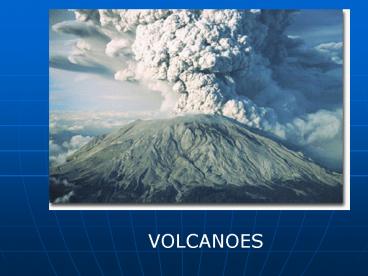VOLCANOES - PowerPoint PPT Presentation
1 / 22
Title: VOLCANOES
1
VOLCANOES
2
A volcano is made of a vent, a pipe, a crater,
and a cone. Most volcanoes also have a magma
chamber.
3
(No Transcript)
4
The vent is an opening at the Earth's
surface. The pipe is a passageway in the
volcano in which the magma rises through to
the surface during an eruption.
5
The crater is a bowl-shaped depression at the
top of the volcano where volcanic materials
like ash, lava, and other pyroclastic materials
are released. When the floor of a crater
collapses into the cone, it forms a caldera.
6
Solidified lava, ashes, and cinder form the
cone. Layers of lava, alternate with layers
of ash to build the steep sided cone higher
and higher.
7
Volcanologists have classified volcanoes into
groups based on the shape of the volcano, the
materials they are built of, and the way the
volcano erupts.
8
Composite volcanoes, also called strato
volcanoes, are formed by alternating layers of
lava and rock fragments. This is the reason
they are called composite.
9
Shield volcanoes are huge in size. They are
built by many layers of runny lava flows. Lava
spills out of a central vent or group of vents.
A broad shaped, gently sloping Cone is formed.
10
A cinder cone is a steep conical hill formed
above a vent. Cinder cones are among the most
common volcanic landforms found in the world.
11
An eruption begins when pressure on a magma
chamber forces magma up through the conduit and
out the volcano's vents. .
12
When the magma chamber has been completely
filled, the type of eruption partly depends on
the amount of gases and silica in the magma.
13
The amount of silica determines how sticky
(level of viscosity) the magma is and water
provides the explosive potential of steam
14
SUBDUCTION ZONE VOLCANOES
When an old, hard edge of an oceanic plate slides
into and underneath a more buoyant continental
plate, the wet oceanic plate sinks into the
mantle, its absorbed water rising into the
overlying mantle. This water causes the
overlying mantle to melt to form magma. Bubbles
of sulphur dioxide, water vapour and carbon
dioxide rise with the magma, growing in size as
they approach the Earth's surface. Like a can of
pop shaken too hard, the gases want out. When
that happens, we have a volcanic eruption. The
more gas there is, the faster it will force its
way out, and the more likely it will explode
when it gets to the surface.
15
(No Transcript)
16
DIVERGENT BOUNDARY VOLCANOES
While volcanic eruptions at subduction zones
have historically posed the greatest hazard to
human civilization, most volcanoes erupt under
the sea at mid-ocean ridges where tectonic
plates pull apart and magma rises to fill the
gap. As the magma hardens, it becomes part of
the existing plates, extending them. There is
debate over whether the magma causes the plates
to move apart or if the magma reacts to fill in
the space.
17
(No Transcript)
18
A small number of volcanic eruptions occur not
at plate boundaries but in the middle of one. It
is believed that there are "hot spots" around the
world where magma, less dense than the
surrounding rock, rises up through structurally
weak zones and bursts through a tectonic plate.
As the plate moves, bursts of magma create a
string of volcanoes. This creates a volcanic
chain such as the Hawaiian Islands.
19
(No Transcript)
20
- Review Questions
- Name the five parts of a volcano.
- How are a vent and a
- pipe related?
- What is the difference between
- a crater and a caldera?
21
Review Questions 4. What materials form the
cones of most volcanoes? 5. Name and describe
the three types of volcanic cones. 6. Describe
the process of volcanic eruption.
22
- Review Questions
- Explain how subduction zone
- volcanoes form.
- 8. Explain how divergent zone
- Volcanoes form.
- 9. Explain how hot spot
- volcanoes form.































